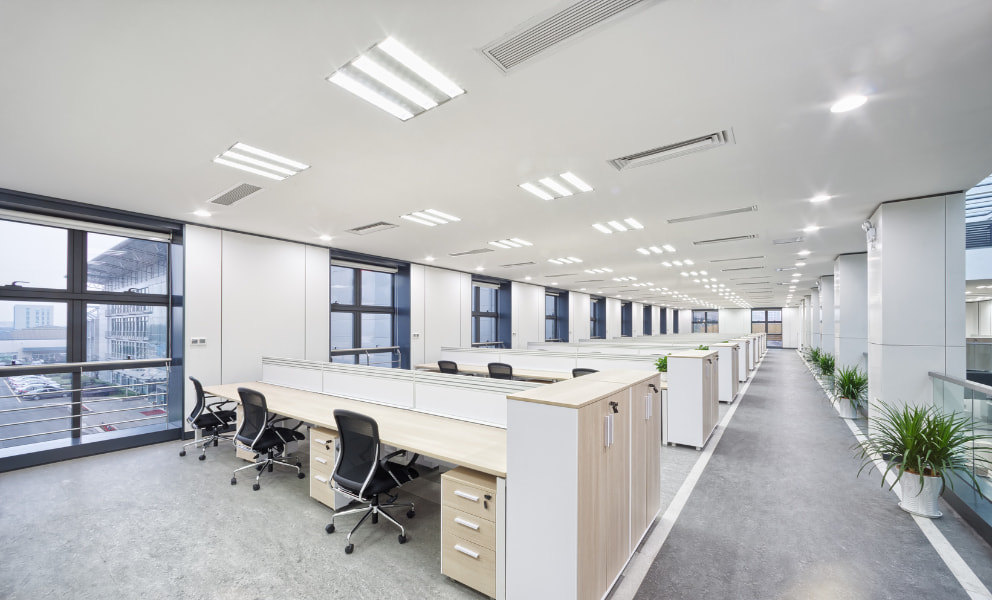
Clarifying Misconceptions in Lighting and HVAC Integration
What’s changed to shift the lighting conversation to consulting engineers rather than electricians? Every technology prior to LED has been based on a prescribed form factor lamp with either a filament rate or a gas discharge. These lights could simply be turned on or off.
LED is the first solid-state design that can be electronically controlled. This electronic control enables a rainbow of LED lighting color and a variety of light levels to suit users’ needs and personal preferences. Even more importantly, LED lighting controls can now be integrated into other building systems as part of a consulting engineer’s building planning process.
Why Integrate Lighting and HVAC?
While there are some common misconceptions around what it takes to integrate lighting and HVAC in your new construction project, the first question really is: why integrate in the first place?
It starts with potential energy savings for your customer. Although lighting and heating, ventilation and air conditioning (HVAC) systems together represent more than 50 percent of a building’s total energy use, according to the U.S. Energy Information Administration, integration can help reduce this by optimizing energy efficiency.
What’s in it for you? Together, lighting and HVAC integration go beyond the benefits of either independent system to provide customers the ability to control lighting and HVAC systems using one platform. Once you know a customer is interested in maximizing energy savings, you can specify and design a building automation system capable of more than just HVAC control.
If your customer’s business is driven by specific sustainability objectives, the energy savings that integration can generate can help reduce their carbon footprint and meet corporate sustainability goals.
The ability to meet sustainability goals is increasingly important as more and more companies incorporate these goals into their corporate objectives. As a part of Trane Technologies, the Trane Commercial business has added its pledge to the Trane Technologies Gigaton Challenge: a commitment to reduce one gigaton of carbon emissions from our customers’ footprint by 2030. With lighting integration, we address system-level energy efficiency to contribute to this goal and empower our customers with a building automation system that enhances regulatory resiliency.
Illuminating Four Misconceptions
There’s a lot of misinformation surrounding lighting and HVAC integration. Here are some facts that address those misconceptions:
Misconception #1: “Lighting and HVAC integration won’t generate sufficient payback so it’s not worth the investment”
Reality: Integration can help to reduce the payback period on your lighting investment
While adding lighting controls does indeed require additional investment, it is important to note that integrating lighting controls into mechanical systems and plug loads can provide energy savings that can reduce the time needed to recover your investment. If you are investing in controls, it makes sense to take it to the next level to integrate these savings and reduce your payback period accordingly.
Integration can help to reduce the payback period for a networked lighting control (NLC) investment. For example. field research in Minnesota conducted by the non-profit Slipstream,1 showed that integrating lighting and HVAC controls generated a 67 percent reduction in lighting energy use and a 47 percent reduction in HVAC energy use. By leveraging occupancy signals from the lighting system to optimize HVAC controls, the project payback period dropped 80 percent from 30 years to around 5 years, including available incentives.
In addition to offering a reduced payback period, integrating lighting controls and HVAC requires a fraction of the investment needed to independently install and use these respective controls systems. When you integrate lighting with HVAC you get mechanical savings on top of lighting savings. Since most new buildings require a network lighting control system to meet code requirements, lighting controls will be specified already.
Misconception #2: Lighting Systems cannot talk to each other
Reality: Lighting systems can talk to each other if you know what you’re doing
While it has been critical in the past to ensure operability between multiple vendors, in most cases today, that’s not an issue. Today’s non-proprietary systems simplify integration. Most building management systems are built on BACnet or other open standard protocols. At the same time, while these open protocols do simplify the process, turning to an experienced energy service provider who understands the demands of integration can help you to simplify the process.
Misconception #3: Integration is too hard to coordinate
Reality: An expert can simplify coordination of lighting and HVAC integration for you
While integration can bring challenges, an expert in building automation can simplify any involvement on your part. While some consulting engineers are concerned that it will be challenging to coordinate work with multiple contractors, working with an energy service provider like Trane simplifies this process.
Trane provides a “one-stop-shop” for consulting engineers since we already have established relationships with nearly two dozen top lighting manufacturers. By working with an energy service company, you gain an expert who brings extensive experience in implementing lighting, extensive experience in implementing HVAC – and extensive experience in integrating the two.
Misconception #4: Lighting and HVAC integration is a “nice to have”, not an imperative
Reality: HVAC and lighting integration is increasingly a requirement – and may already be so for your project
While integrating the lighting and HVAC system is a “nice to do” because it will maximize energy savings for building owners, it’s also increasingly becoming a requirement in some locations. As demand-response programs become more closely regulated to help address electrical grid capacity by managing customer demand, customers will need integrated systems to meet these regulations. Building code requirements are already changing to meet these new regulations. By integrating HVAC and lighting in your new building now, you prepare yourself for future building code and other regulatory requirements.
Learn how Trane can help you integrate lighting and HVAC controls for your next project.
1 Cowan, Clair and Hackel, Scott, “Integrating Lighting and HVAC Controls: Solutions for High Performance Buildings,” Slipstreaminc.org, Nov., 17, 2021
Lighting Solutions

About the author
Doug White, Lighting Solutions Manager for Trane
Doug is responsible for Trane’s North American lighting operations. He deploys a lighting program with centralized decision-making to manage Trane’s $100+ million annual lighting business. Doug is highly experienced in breaking down complex information so it can be understood by all levels within an organization. He presents the financial analysis of a project, taking into account revenue, profit and loss, and return on investment. This allows a customer to weigh the sustainability benefits of more efficient lighting against the economic investment.



































































































